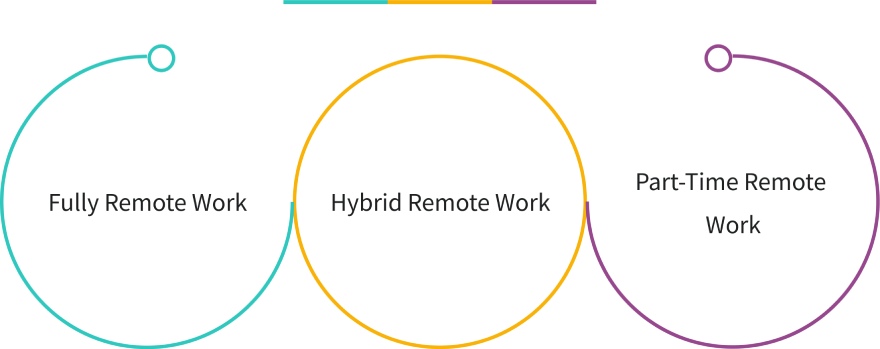Are you finding it challenging to decide between remote and hybrid work for your team? With so many aspects to consider, it’s essential to understand the strengths and weaknesses of each model. In this blog, you will learn about Remote vs Hybrid Work, the pros and cons of each model, and how to choose the right one for your team. Whether you want to get the most out of your work, improve work-life balance, or find the right balance between work and home, it is important to know these options. Let us discuss both models in detail to determine which one will be most suitable for your team.
What is Remote Work?
Remote work, also known as Telecommuting, is a work arrangement where employees work from a location other than the conventional workplace. This could be from home, a co-working space, or any other location with a stable internet connection. Remote work enables the employees to perform their duties and interact with their colleagues through technology. It provides flexibility in working hours and location, with the goal of enhancing work-life balance and efficiency.
Types of Remote Work

As a manager, you may need to familiarize yourself with the various remote work models that your team may adopt. Here are some of the most common types.
Fully Remote Work:
In this setup, your team members work from locations other than the office and are fully remote. They could be working from home, a coffee shop, or while traveling. Since all communication and tasks are handled online, having the right remote work tools is crucial.
Hybrid Remote Work:
Hybrid remote work is a combination of working from home and working from the office. Some of your employees work from home for a few days each week, while the rest of the time, they are in the office. It provides flexibility but it also ensures that there is some face-to-face interaction. You will need to coordinate schedules to keep everyone connected.
Part-Time Remote Work:
Here, employees work remotely for part of the week but may need to come into the office for meetings or specific assignments. It provides flexibility for you and your team and also allows for face-to-face interaction when necessary.
What is Hybrid Work?
Hybrid work is a flexible working model where employees work from home and from the office at different times. This setup enables them to have the advantages of both environments. For instance, they may telecommute two or three days a week and then go to the office for meetings or group projects. It is a good way to balance flexibility with the necessity of face-to-face communication. Managers need to synchronize schedules and ensure that team members remain connected and engaged, whether working from home or in the office.
Types of Hybrid Work

Following are some common types of hybrid work.
Fixed Hybrid Work:
In this model, your employees work remotely and in the office according to a predetermined schedule. For instance, they might go to the office on Monday and Wednesday, but for the rest of the week, they are working from home. This gives you the advantage of knowing when the team will be in the office for meetings or collaboration.
Flexible Hybrid Work:
Here, your employees are allowed to choose which days they will be working from home or from the office. It provides more freedom to the individual, but you will have to pay attention to communication and coordination so that the team members remain connected and effective.
Office-First Hybrid Work:
With this setup, working in the office is preferred, but employees can occasionally work from home. It is helpful when you want to have most of the team members in the office but at the same time, you want to offer some flexibility.
Remote-First Hybrid Work:
In this model, working from home is the norm, and going to the office is done only for certain tasks or meetings. This is perfect for a team that is already set up to work remotely but requires face-to-face meetings every now and then to ensure that everyone is on the same page.
Remote vs Hybrid Work: Exploring the Advantages and Disadvantages
Here you can find the pros and cons of remote and hybrid work to make the right choice for your team.
Advantages of Remote Work:
Below are some of the benefits of remote work that can help your team and organization.
1. Flexibility in Work Hours:
Remote work offers the benefit of flexible working hours. This means that your employees can be able to change their working schedules to suit their needs, which in turn increases their job satisfaction and productivity. For instance, if a person is more effective during the night, he or she can work at night and rest during the day.
2. Increases Productivity:
Remote working minimizes distractions in the workplace since employees can work from home and concentrate on their work. This can lead to increased quality of work and shorter time taken to complete the project.
3. Cost Savings:
Remote work can be cost-effective for your team. Employees do not spend money on fuel and fares and may spend less on clothes and eating out. As a manager, you might also notice cost savings from less need for office space and utilities.
4. Better Work-Life Balance:
Telecommuting is beneficial to employees since it allows them to balance between their professional and personal lives. They do not have to commute to work and have more control over their working conditions, thus they can spend more time with their families and engage in other activities. This balance usually results in happier and more motivated employees.
5. Access to a Broader Talent Pool:
One of the benefits of remote work is that you can hire the best talent regardless of the location. This increases the pool of candidates and is useful in assembling a talented and diverse workforce.
Disadvantages of Remote Work:
Here are some disadvantages of remote work.
1. Lack of Direct Supervision and Monitoring Performance:
One of the main disadvantages of having employees work remotely is that you cannot monitor them as closely. This can be challenging to manage because it is difficult to monitor everyone’s work and ensure they are on track and meeting their deadlines.
2. Reduces Team Collaboration:
When your team works remotely, collaboration may become difficult. You lose the ability to have impulsive idea generation and immediate problem-solving, which can negatively affect the pace of the project and creativity.
3. Communication Issues:
Virtual communication is that it is not as effective as face-to-face communication because it is often characterized by misunderstandings and delays. It is more difficult to ensure that all the team members are in a similar understanding, which may affect the project schedules and the team spirit.
4. Security Concerns:
Remote work can present security concerns. If your employees are using their own devices or unsecured networks, then your company’s sensitive information may be compromised. This makes it difficult for you to have good cybersecurity measures in place.
Advantages of Hybrid Work:
Here are some main advantages of hybrid work that can help your team and organization.
1. Flexibility for Your Team:
Hybrid work allows your team to work both in the office and remotely, which means that they can divide their time between the two. This flexibility can enhance work-life balance, helping employees manage their personal and professional lives better.
2. Increases Productivity:
Employees who are allowed to work from home can easily escape the common interferences that are characteristic of the regular workplace. This can lead to more focused work and higher levels of productivity.
3. Cost Savings:
Hybrid work can also be beneficial in terms of cutting overhead expenses for your business. Since there are likely to be fewer employees in the office at any one time, it may be possible to reduce the size of the office or cut down on utility costs.
4. Attract and Retain Talent:
Adopting a hybrid work model is beneficial for your company because it increases the chances of attracting new talent and retaining existing employees. Flexibility has become a very important factor for many professionals and they are willing to work for or join an organization that offers it.
5. Better Employee Well-being:
Enabling employees to work from home part of the time can be beneficial to their mental health and reduce stress. Employees can arrange their working space according to their preferences and have a less formal atmosphere, which is beneficial for health.
Disadvantages of Hybrid Work:
The following are the disadvantages of hybrid work.
1. Communication Challenges:
One disadvantage of hybrid work is that it can complicate communication. Since the team members are working both in the office and at home, you may experience a challenge in scheduling meetings and making sure everyone is on the same page. That is why it is necessary to apply the proper tools and methods to overcome the challenges maintain effective communication.
2. Team Cohesion Issues:
When some employees are working from home while others are in the office, it can affect the cohesiveness of the team. You may find it challenging to develop good interpersonal relations and create a coherent team atmosphere. This gap can be closed through check-ins and team-building activities.
3. Technology and Access Problems:
In a hybrid work setup, it’s essential that employees have access to the right tools. Not all may have the same quality of equipment or internet connection at home. This can result in technical problems and inequality in the distribution of resources, which in turn affects productivity. Make sure that all the members of the team are equipped with the necessary tools.
4. Management and Supervision Difficulties:
Managing a hybrid team can be challenging. This is because it becomes difficult to monitor the progress and provide support to the employees when they are working from home and at the same time those who are physically in the office. It is easier when there are well defined expectations and management tools available.
5. Work-Life Balance Confusion:
While hybrid work offers flexibility, it also poses the risk of work-life integration, where the two domains become indistinguishable. This is because employees may not easily distinguish between working and non-working hours. This problem can be solved by ensuring that there are clear boundaries and that there is proper time management.
Now that we’ve explored the advantages and challenges of hybrid work, let’s dive into how to decide whether a remote or hybrid work model is the right fit for your team.
Remote or Hybrid: How to select the best model for your teams
Selecting the right work model for your team can go a long way in improving their efficiency and morale. Regardless of the approach you take, remote or hybrid, the goal is to create an environment that will allow your team to perform at its best.
Understand Your Team’s Needs:
The first step is to find out what your team likes. There are individuals who prefer to work remotely and there are those who prefer going to the office. Ask them to fill out a survey or talk to them to find out what is most effective for them. This will assist you in making a decision that will enhance their comfort and productivity.
Evaluate the Nature of the Work:
Think about the nature of the work your team performs. If tasks involve a lot of communication or require face-to-face interaction, then a hybrid model may be more beneficial. For less interdependent tasks, remote work could be appropriate. Consider how often your team requires face-to-face collaboration to decide what setup is most effective.
Consider Productivity:
Assess the ways your team functions in different settings. Determine the productivity rates of employees under remote and hybrid environments. If performance is negatively affected by remote work, then a hybrid model might be more appropriate. But if their productivity is constant, then working from home could be a long-term solution to the problem.
Communication and Collaboration Tools:
Make sure your team has the right communication and collaboration tools regardless of the work model in place. Ensure that your team is connected through video conferencing, project management software, and instant messaging to ensure that projects are on track.
Flexibility and Adaptability:
Be ready to adapt your work model as and when necessary. The best approach that is effective today may not be the same tomorrow, so always be willing to listen to feedback and be prepared to make changes. A hybrid model provides flexibility and enables you to work remotely and, in the office, depending on the circumstances.
Conclusion
Deciding between remote and hybrid work involves assessing your team’s requirements and the type of work they do. Remote work is advantageous because it is flexible and inexpensive but challenging in terms of communication and supervision. The advantages of both environments are incorporated in hybrid work, but it may also bring coordination and technology challenges. Determine what is best for your team, and make sure you have the right equipment for the communication to be effective. Be flexible and open to suggestions to develop a work model that will be productive and satisfying.
Optimize your team's productivity in remote and hybrid work settings with Time Champ today!
Start your 7-day free trial. No credit card required
Signup for FreeBook DemoFrequently Asked Questions
Remote work means that employees perform their tasks at a location that is different from the workplace, for instance, at home or in a co-working space, while hybrid work means that employees work partly remotely and partly in the office, meaning that they can work from home for some days in the week and go to the office for the rest of the days in the week.
Consider the nature of the job, the amount of communication needed, the employees’ preferences, and the company culture. Remote work is flexible, while hybrid work allows for collaboration. Choose carefully depending on the efficiency, activity, and alignment with your teams’ goals and objectives.
Make sure that the team remains motivated by encouraging communication, flexible working hours, face-to-face and online meetings. Offer incentives for performance and support work life balance in a hybrid setting.
Use passwords, encrypt, and secure connections. Ensure that software is up to date and offer training on security measures to the employees. Control the access and data usage to secure the information in the remote or the hybrid environment.
Promote communication in a hybrid work setting by employing the use of communication tools, having set meetings, embracing the culture of open discussions, and ensuring that everyone is well informed.







